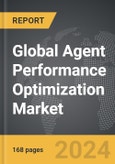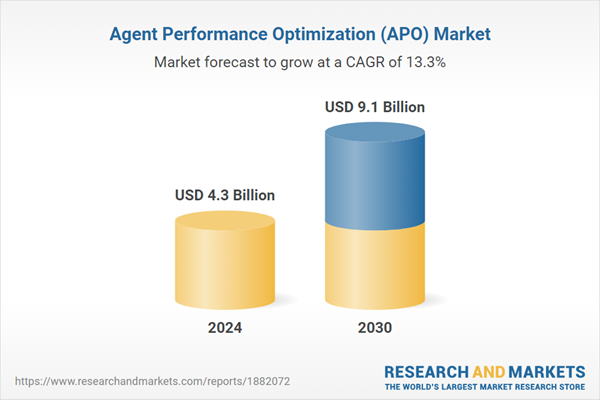The global market for Agent Performance Optimization (APO) was valued at US$4.3 Billion in 2024 and is projected to reach US$9.1 Billion by 2030, growing at a CAGR of 13.3% from 2024 to 2030. This comprehensive report provides an in-depth analysis of market trends, drivers, and forecasts, helping you make informed business decisions. The report includes the most recent global tariff developments and how they impact the Agent Performance Optimization (APO) market.
In the highly competitive landscape of customer service, businesses are increasingly adopting APO tools to gain a strategic edge. These tools not only help in tracking key performance indicators (KPIs) such as average handling time, first call resolution, and customer satisfaction scores, but also provide actionable feedback to agents. For instance, speech analytics can identify common issues and sentiment during calls, guiding agents on how to improve their communication skills and problem-solving techniques. Furthermore, AI-driven chatbots and virtual assistants are being integrated with APO systems to assist agents in real-time, offering suggestions and retrieving relevant information, which enhances the overall efficiency and quality of service. The integration of APO with workforce management systems also ensures optimal scheduling and workload distribution, thereby minimizing agent burnout and attrition.
The growth in the agent performance optimization market is driven by several factors. Technological advancements, particularly in AI and machine learning, have significantly enhanced the capabilities of APO solutions, making them more intuitive and effective. The increasing complexity of customer interactions, driven by the proliferation of digital channels and the rising expectation for seamless, omnichannel experiences, has necessitated the adoption of advanced APO tools. Businesses are also recognizing the importance of employee engagement and satisfaction in delivering superior customer service, which has led to a greater emphasis on personalized coaching and development programs facilitated by APO systems. Additionally, the growing trend towards remote and hybrid work models has highlighted the need for robust APO solutions that can ensure consistent performance and support regardless of location. Regulatory requirements and the need for compliance in handling customer data and interactions are also propelling the demand for sophisticated performance optimization tools. Collectively, these factors are driving the expansion and evolution of the APO market, making it a critical component of modern contact center operations.
Segments: Type (Cloud Based, On-Premises); Application (Small & Mid-sized Businesses, Large Enterprises).
Geographic Regions/Countries: World; United States; Canada; Japan; China; Europe (France; Germany; Italy; United Kingdom; Spain; Russia; and Rest of Europe); Asia-Pacific (Australia; India; South Korea; and Rest of Asia-Pacific); Latin America (Argentina; Brazil; Mexico; and Rest of Latin America); Middle East (Iran; Israel; Saudi Arabia; United Arab Emirates; and Rest of Middle East); and Africa.
The analysts continuously track trade developments worldwide, drawing insights from leading global economists and over 200 industry and policy institutions, including think tanks, trade organizations, and national economic advisory bodies. This intelligence is integrated into forecasting models to provide timely, data-driven analysis of emerging risks and opportunities.
Agent Performance Optimization (APO) - Key Trends and Drivers
Agent Performance Optimization (APO) refers to a suite of strategies and tools designed to enhance the efficiency, productivity, and overall effectiveness of customer service agents within a contact center environment. By leveraging advanced technologies such as artificial intelligence (AI), machine learning, and data analytics, APO solutions provide comprehensive insights into agent performance, identifying areas for improvement and enabling targeted interventions. These solutions encompass a range of functionalities including real-time monitoring, automated coaching, performance analytics, and personalized training programs. The primary goal of APO is to ensure that customer service agents are well-equipped to handle interactions effectively, thereby improving customer satisfaction, reducing handling times, and optimizing resource utilization.In the highly competitive landscape of customer service, businesses are increasingly adopting APO tools to gain a strategic edge. These tools not only help in tracking key performance indicators (KPIs) such as average handling time, first call resolution, and customer satisfaction scores, but also provide actionable feedback to agents. For instance, speech analytics can identify common issues and sentiment during calls, guiding agents on how to improve their communication skills and problem-solving techniques. Furthermore, AI-driven chatbots and virtual assistants are being integrated with APO systems to assist agents in real-time, offering suggestions and retrieving relevant information, which enhances the overall efficiency and quality of service. The integration of APO with workforce management systems also ensures optimal scheduling and workload distribution, thereby minimizing agent burnout and attrition.
The growth in the agent performance optimization market is driven by several factors. Technological advancements, particularly in AI and machine learning, have significantly enhanced the capabilities of APO solutions, making them more intuitive and effective. The increasing complexity of customer interactions, driven by the proliferation of digital channels and the rising expectation for seamless, omnichannel experiences, has necessitated the adoption of advanced APO tools. Businesses are also recognizing the importance of employee engagement and satisfaction in delivering superior customer service, which has led to a greater emphasis on personalized coaching and development programs facilitated by APO systems. Additionally, the growing trend towards remote and hybrid work models has highlighted the need for robust APO solutions that can ensure consistent performance and support regardless of location. Regulatory requirements and the need for compliance in handling customer data and interactions are also propelling the demand for sophisticated performance optimization tools. Collectively, these factors are driving the expansion and evolution of the APO market, making it a critical component of modern contact center operations.
Report Scope
The report analyzes the Agent Performance Optimization (APO) market, presented in terms of units. The analysis covers the key segments and geographic regions outlined below.Segments: Type (Cloud Based, On-Premises); Application (Small & Mid-sized Businesses, Large Enterprises).
Geographic Regions/Countries: World; United States; Canada; Japan; China; Europe (France; Germany; Italy; United Kingdom; Spain; Russia; and Rest of Europe); Asia-Pacific (Australia; India; South Korea; and Rest of Asia-Pacific); Latin America (Argentina; Brazil; Mexico; and Rest of Latin America); Middle East (Iran; Israel; Saudi Arabia; United Arab Emirates; and Rest of Middle East); and Africa.
Key Insights:
- Market Growth: Understand the significant growth trajectory of the Cloud Based segment, which is expected to reach US$6.8 Billion by 2030 with a CAGR of a 14.2%. The On-Premises segment is also set to grow at 10.8% CAGR over the analysis period.
- Regional Analysis: Gain insights into the U.S. market, valued at $1.2 Billion in 2024, and China, forecasted to grow at an impressive 18.3% CAGR to reach $2.2 Billion by 2030. Discover growth trends in other key regions, including Japan, Canada, Germany, and the Asia-Pacific.
Why You Should Buy This Report:
- Detailed Market Analysis: Access a thorough analysis of the Global Agent Performance Optimization (APO) Market, covering all major geographic regions and market segments.
- Competitive Insights: Get an overview of the competitive landscape, including the market presence of major players across different geographies.
- Future Trends and Drivers: Understand the key trends and drivers shaping the future of the Global Agent Performance Optimization (APO) Market.
- Actionable Insights: Benefit from actionable insights that can help you identify new revenue opportunities and make strategic business decisions.
Key Questions Answered:
- How is the Global Agent Performance Optimization (APO) Market expected to evolve by 2030?
- What are the main drivers and restraints affecting the market?
- Which market segments will grow the most over the forecast period?
- How will market shares for different regions and segments change by 2030?
- Who are the leading players in the market, and what are their prospects?
Report Features:
- Comprehensive Market Data: Independent analysis of annual sales and market forecasts in US$ Million from 2024 to 2030.
- In-Depth Regional Analysis: Detailed insights into key markets, including the U.S., China, Japan, Canada, Europe, Asia-Pacific, Latin America, Middle East, and Africa.
- Company Profiles: Coverage of players such as Aspect Software, Inc., Calabrio, Inc., CallFinder, CallMiner, Inc., Envision Telephony, Inc. and more.
- Complimentary Updates: Receive free report updates for one year to keep you informed of the latest market developments.
Some of the 14 companies featured in this Agent Performance Optimization (APO) market report include:
- Aspect Software, Inc.
- Calabrio, Inc.
- CallFinder
- CallMiner, Inc.
- Envision Telephony, Inc.
- Five9, Inc.
- Genesys Telecommunications Laboratories, Inc.
- HigherGround, Inc.
- InVision AG
- NICE Ltd.
- Teleopti AB
- Upstream Works Software Ltd.
- Verint Systems, Inc.
- ZOOM International A.S.
Tariff Impact Analysis: Key Insights for 2025
Global tariff negotiations across 180+ countries are reshaping supply chains, costs, and competitiveness. This report reflects the latest developments as of April 2025 and incorporates forward-looking insights into the market outlook.The analysts continuously track trade developments worldwide, drawing insights from leading global economists and over 200 industry and policy institutions, including think tanks, trade organizations, and national economic advisory bodies. This intelligence is integrated into forecasting models to provide timely, data-driven analysis of emerging risks and opportunities.
What’s Included in This Edition:
- Tariff-adjusted market forecasts by region and segment
- Analysis of cost and supply chain implications by sourcing and trade exposure
- Strategic insights into geographic shifts
Buyers receive a free July 2025 update with:
- Finalized tariff impacts and new trade agreement effects
- Updated projections reflecting global sourcing and cost shifts
- Expanded country-specific coverage across the industry
Table of Contents
I. METHODOLOGYII. EXECUTIVE SUMMARY2. FOCUS ON SELECT PLAYERSIII. MARKET ANALYSISSOUTH KOREAREST OF ASIA-PACIFICARGENTINABRAZILMEXICOREST OF LATIN AMERICAIRANISRAELSAUDI ARABIAUNITED ARAB EMIRATESREST OF MIDDLE EASTIV. COMPETITION
1. MARKET OVERVIEW
3. MARKET TRENDS & DRIVERS
4. GLOBAL MARKET PERSPECTIVE
UNITED STATES
CANADA
JAPAN
CHINA
EUROPE
FRANCE
GERMANY
ITALY
UNITED KINGDOM
SPAIN
RUSSIA
REST OF EUROPE
ASIA-PACIFIC
AUSTRALIA
INDIA
LATIN AMERICA
MIDDLE EAST
AFRICA
Companies Mentioned (Partial List)
A selection of companies mentioned in this report includes, but is not limited to:
- Aspect Software, Inc.
- Calabrio, Inc.
- CallFinder
- CallMiner, Inc.
- Envision Telephony, Inc.
- Five9, Inc.
- Genesys Telecommunications Laboratories, Inc.
- HigherGround, Inc.
- InVision AG
- NICE Ltd.
- Teleopti AB
- Upstream Works Software Ltd.
- Verint Systems, Inc.
- ZOOM International A.S.
Table Information
| Report Attribute | Details |
|---|---|
| No. of Pages | 168 |
| Published | April 2025 |
| Forecast Period | 2024 - 2030 |
| Estimated Market Value ( USD | $ 4.3 Billion |
| Forecasted Market Value ( USD | $ 9.1 Billion |
| Compound Annual Growth Rate | 13.3% |
| Regions Covered | Global |









